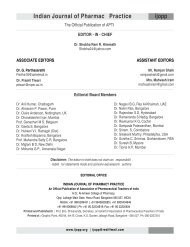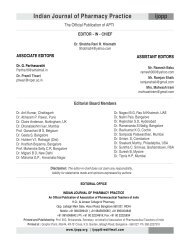<strong>Indian</strong> J. Pharm. Pract. 1(2), Jan-Mar, 2009Table 2. Categorisation <strong>of</strong> medication-related problems (after Strand et al.)Indication without drug therapyThe patient has a medical problem that requires medication therapy (an indication formedication use) but is not receiving a medication for that indication.Patient with heavy alcohol abuse but no thiamine has been ordered.Drug use without indicationThe patient is taking a medication for which there is no medically valid indication.Patient with acute agitation in hospital that has resolved post-discharge continuestreatment with tranquillisers initiated as an inpatient.Improper drug selectionThe patient has a medication indication but is taking the wrong drug.Delirium due to a urinary tract infection has been diagnosed, and antibiotic therapy hasbeen prescribed, but the organism involved is not sensitive to the antibiotic that has beenchosen.Sub-therapeutic dosageThe patient has a medical problem that is being treated with too little <strong>of</strong> the correctmedication.After initiation <strong>of</strong> an antipsychotic drug, blood glucose concentrations remainunacceptably elevated despite the use <strong>of</strong> insulin; dosage must be increased to achievedesired control.Over-dosageThe patient has a medical problem that is being treated with too much <strong>of</strong> the correctmedication.A patient is prescribed a very large dose <strong>of</strong> an antipsychotic drug: the magnitude <strong>of</strong> thedosage does not create additional antipsychotic benefit but generates severeextrapyramidal side effects.Adverse drug reaction (ADR)The patient has a medical problem that is the result <strong>of</strong> an ADR or adverse effect.The patient develops nausea, vomiting and diarrhoea as a result <strong>of</strong> treatment with anantidepressant.Drug interactionThe patient has a medical problem that is the result <strong>of</strong> a medication-medication,medication-laboratory, or medication-food interaction.Elevated serum haloperidol concentration with toxicity secondary to hepatic enzymeinhibition arising from SSRI treatment.Failure to receive a drugThe patient has a medical problem that is the result <strong>of</strong> not receiving a medication thatwas intended as a part <strong>of</strong> the designed treatment regimen.Patient is prescribed an expensive, non-subsidised drug therapy and has not received anycounselling about the expected benefits <strong>of</strong> therapy. The patient does not have theprescription filled and does not adhere to the established treatment plan.6
<strong>Indian</strong> J. Pharm. Pract. 1(2), Jan-Mar, 2009References1 Taylor K, Nettlesdon S, Harding G. Sociology for health facilities. Hospitals 1977; 51: 71–74.ndpharmacists: an introduction. 2 ed; Taylor and 17 Berchou RC. Effect <strong>of</strong> a consultant pharmacist onFrancis, New York, USA; 2003.medication use in an institution for the mentally2 Anderson S. The state <strong>of</strong> the world's pharmacy: a retarded. Am J Hosp Pharm 1982; 39: 1671 – 1674.portrait <strong>of</strong> the pharmacy pr<strong>of</strong>ession. J Interpr<strong>of</strong> Care 18 Saklad SR, Ereshefsky L, Jann MW, Crimson ML.2002; 16: 391 – 404.Clinical pharmacists' impact on prescribing in an3 Kirk EG. Ward pharmacist - regional pharmacist. acute adult psychiatric facility. DICP; 1984; 18: 6324Aust J Hosp Pharm 1971; 1:27 – 30. –634.Calder G, Barnett JW. The pharmacist in the ward. 19 Stanislav SW, Barker K, Crimson L, Childs A.Pharm J 1967; 198: 584 -586.Effects <strong>of</strong> a clinical psychopharmacy consultation5 Francke GN. Evolvement <strong>of</strong> "clinical pharmacy".service on patient outcomes. Am J Hosp PharmDrug Intell Clin Pharm 1969; 3: 348 – 354.1994; 51: 778 –7 81.6 Borgsdorf LR, McLeod DC, Smith Jr WE, Tatro DS.20 Baigent, B. Evaluation <strong>of</strong> clinical pharmacy in aImplementing clinical pharmacy services an AJHPmental health unit. Pharmaceutical <strong>Journal</strong> 1993;roundtable discussion. Am J Hosp Pharm 1973; 3:250: 150 – 153.672 – 682. 21 Cloete BG. Costs and benefits <strong>of</strong> multi-disciplinary7 Cousins HD, Luscombe D. Re-engineering pharmacymedication review in a long-stay psychiatric ward.practice. Forces for change and the evolution <strong>of</strong>Pharmaceutical <strong>Journal</strong> 1992; 249: 102 – 103.clinical pharmacy practice. Pharm J 1995; 225: 771 22 Lobeck F, Traxler WT, Bibinet DD. The cost-–77 6.effectiveness <strong>of</strong> a clinical pharmacy service in an8 Hepler CD. The third wave in pharmaceuticalout-patient mental health clinic. Hosp Communityeducation: the clinical movement. Am J Pharm EducPsychiatry 1989; 40: 643 – 645.1987; 51: 369 – 385.23 Dorevitch A, Perl E. The impact <strong>of</strong> clinical pharmacy9 Commonwealth Department <strong>of</strong> Health, Housing andinterventions in an acute psychiatric hospital.Community Services. A policy on the quality use <strong>of</strong><strong>Journal</strong> <strong>of</strong> Clinical <strong>Pharmacy</strong> and Therapeuticsmedicines. Canberra: Commonwealth Department <strong>of</strong>1996; 21: 45 - 48.Health, Housing and Community Services; 1992.24 Ewan MA, Greene RJ. Evaluation <strong>of</strong> mental health10 Anon. Preliminary report <strong>of</strong> the task force oncare interventions made by three communityspecialties in pharmacy. J Am Pharm Assoc 1974; 14:58 – 60.pharmacists - a pilot study. Int J Pharm Pract 2001; 9:11 Augustin SG, Puzantian T, Caley CF, Marken PA, 225 –2 34.Richards AL, Levin GM. Psychiatric pharmacists.25 Haw C, Stubbs J. Prescribing errors at a psychiatricAm J Psychiatry 2001; 158.hospital. <strong>Pharmacy</strong> Prac 2003; 13: 64 –6 6.12 Canales PL, Dorson PG, Crismon ML. Outcomes 26 Stubbs J, Haw C, Taylor D. Prescription errors inassessment <strong>of</strong> clinical pharmacy services in a psychiatry–a multi-centre study. J Psychopharma-psychiatric inpatient setting. Am J Health-Sys Pharm col. 2006 Jan 9; [Epub ahead <strong>of</strong> print]27 Alderman CP. A prospective analysis <strong>of</strong> clinical2001; 58: 1309 – 16.13 Alderman CP. Doctoral research thesis: Specialist pharmacy interventions on an acute inpatientclinical pharmacy services in the care <strong>of</strong> patients with psychiatric unit. J Clin Pharm Ther 1997; 22: 27 - 31.psychiatric illness: An assessment <strong>of</strong> the contribution28 O'Hare JD, McKee HA, D'Arcy PF. Analysis <strong>of</strong> drugto optimal health outcomes and implications forinformation queries received by the pharmacy in apharmacy practice. University <strong>of</strong> South Australialarge psychiatric hospital. J Clin Hosp Pharm 1984;2008.9:139 –1 42.14 Psychotherapeutic medication in Australia: report <strong>of</strong> 29 Strand LM, Morley CP, Cipolle RJ, Ramsey R,the Senate Community Affairs Reference Committee. Lamsam GD. Drug-related problems: their structure(1995) Canberra, AGPS.and function. DICP 1990; 24: 1093 –1097.15 Lacro JP, Jeste DV. Physical co-morbidity and 30 Dooley MJ, Bogovic A, Carroll M, Cuell S, Galpolypharmacyin older psychiatric patients. Biol bratith K, Matthews H. SHPA Standards <strong>of</strong> practicepsychiatry 1994; 36: 146 –152.for clinical pharmacy. J Pharm Pract Res 2005; 35:16 Stimmel GL. Clinical pharmacy services in mental 122 – 146.7
- Page 1: Indian Journal of Pharmacy Practice
- Page 4 and 5: Indian Journal of Pharmacy Practice
- Page 7 and 8: APTIIndian J. Pharm. Pract. 1(2), J
- Page 10 and 11: Indian J. Pharm. Pract. 1(2), Jan-M
- Page 14 and 15: APTIijoppGenesis, Development and P
- Page 16 and 17: Indian J. Pharm. Pract. 1(2), Jan-M
- Page 19 and 20: Indian J. Pharm. Pract. 1(2), Jan-M
- Page 21 and 22: Indian J. Pharm. Pract. 1(2), Jan-M
- Page 23 and 24: Indian J. Pharm. Pract. 1(2), Jan-M
- Page 25 and 26: Indian J. Pharm. Pract. 1(2), Jan-M
- Page 27 and 28: Indian J. Pharm. Pract. 1(2), Jan-M
- Page 29 and 30: Indian J. Pharm. Pract. 1(2), Jan-M
- Page 31 and 32: Indian J. Pharm. Pract. 1(2), Jan-M
- Page 33 and 34: Indian J. Pharm. Pract. 1(2), Jan-M
- Page 35 and 36: Indian J. Pharm. Pract. 1(2), Jan-M
- Page 37 and 38: Indian J. Pharm. Pract. 1(2), Jan-M
- Page 39 and 40: Indian J. Pharm. Pract. 1(2), Jan-M
- Page 41 and 42: Indian J. Pharm. Pract. 1(2), Jan-M
- Page 43 and 44: Indian J. Pharm. Pract. 1(2), Jan-M
- Page 45 and 46: Indian J. Pharm. Pract. 1(2), Jan-M
- Page 47 and 48: Indian J. Pharm. Pract. 1(2), Jan-M
- Page 49 and 50: Indian J. Pharm. Pract. 1(2), Jan-M
- Page 51 and 52: Indian J. Pharm. Pract. 1(2), Jan-M
- Page 53 and 54: pivotal to the rational use of medi
- Page 55 and 56: .leadership” (Cohen, 1984). A stu
- Page 57 and 58: Indian J. Pharm. Pract. 1(2), Jan-M
- Page 59 and 60: Indian J. Pharm. Pract. 1(2), Jan-M
- Page 61 and 62: Indian J. Pharm. Pract. 1(2), Jan-M
- Page 63 and 64:
Indian J. Pharm. Pract. 1(2), Jan-M
- Page 65 and 66:
Indian J. Pharm. Pract. 1(2), Jan-M
- Page 67 and 68:
Indian J. Pharm. Pract. 1(2), Jan-M
- Page 69 and 70:
Indian J. Pharm. Pract. 1(2), Jan-M
- Page 71 and 72:
Indian J. Pharm. Pract. 1(2), Jan-M
- Page 73 and 74:
Indian J. Pharm. Pract. 1(2), Jan-M
- Page 75 and 76:
Indian J. Pharm. Pract. 1(2), Jan-M
- Page 77 and 78:
Indian J. Pharm. Pract. 1(2), Jan-M
- Page 79 and 80:
Indian J. Pharm. Pract. 1(2), Jan-M
- Page 81 and 82:
Indian J. Pharm. Pract. 1(2), Jan-M
- Page 83 and 84:
Indian J. Pharm. Pract. 1(2), Jan-M
- Page 85 and 86:
Indian J. Pharm. Pract. 1(2), Jan-M
- Page 87 and 88:
Indian J. Pharm. Pract. 1(2), Jan-M
- Page 89 and 90:
Indian J. Pharm. Pract. 1(2), Jan-M
- Page 91 and 92:
Indian J. Pharm. Pract. 1(2), Jan-M
- Page 93 and 94:
Indian J. Pharm. Pract. 1(2), Jan-M
















